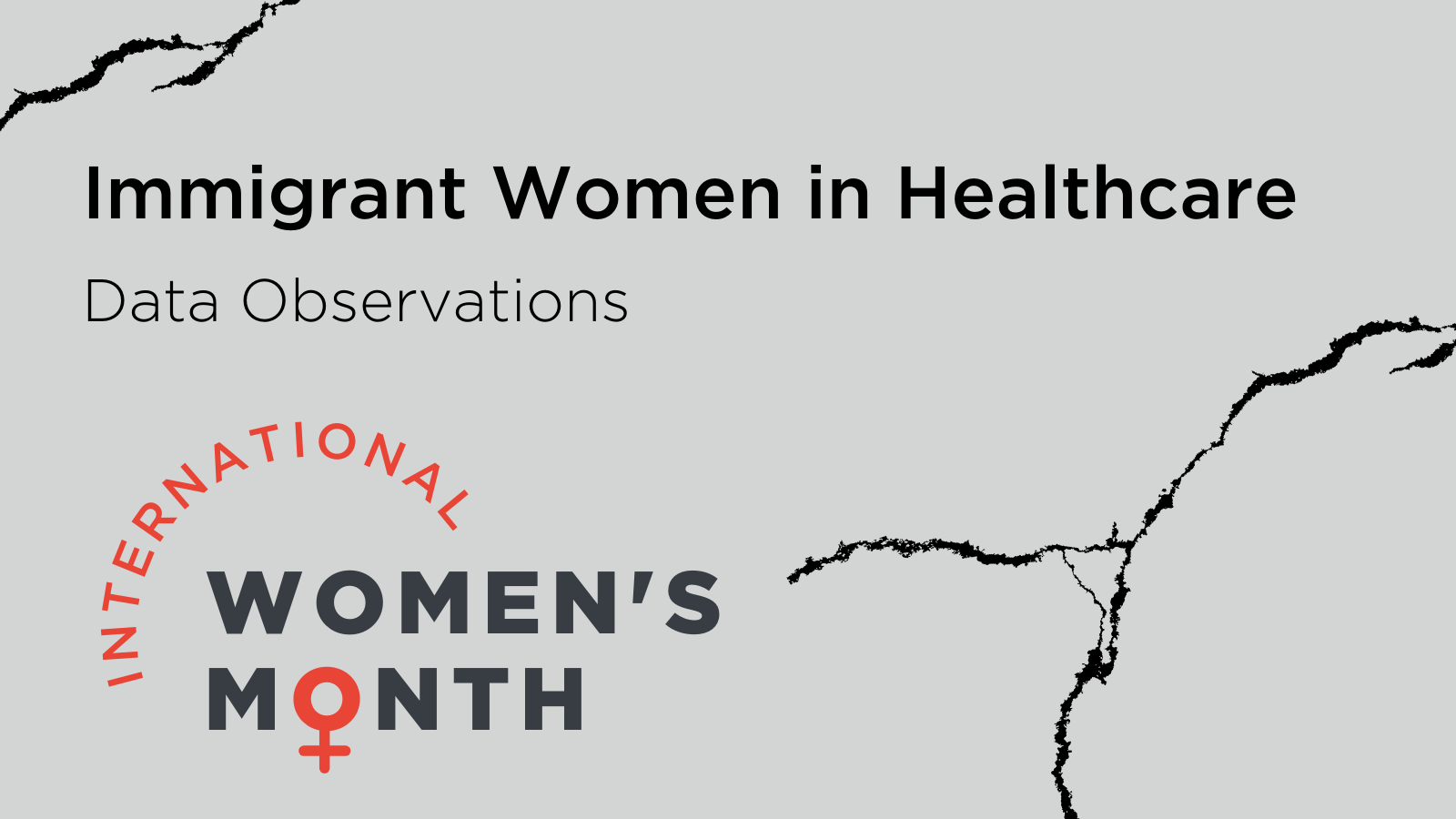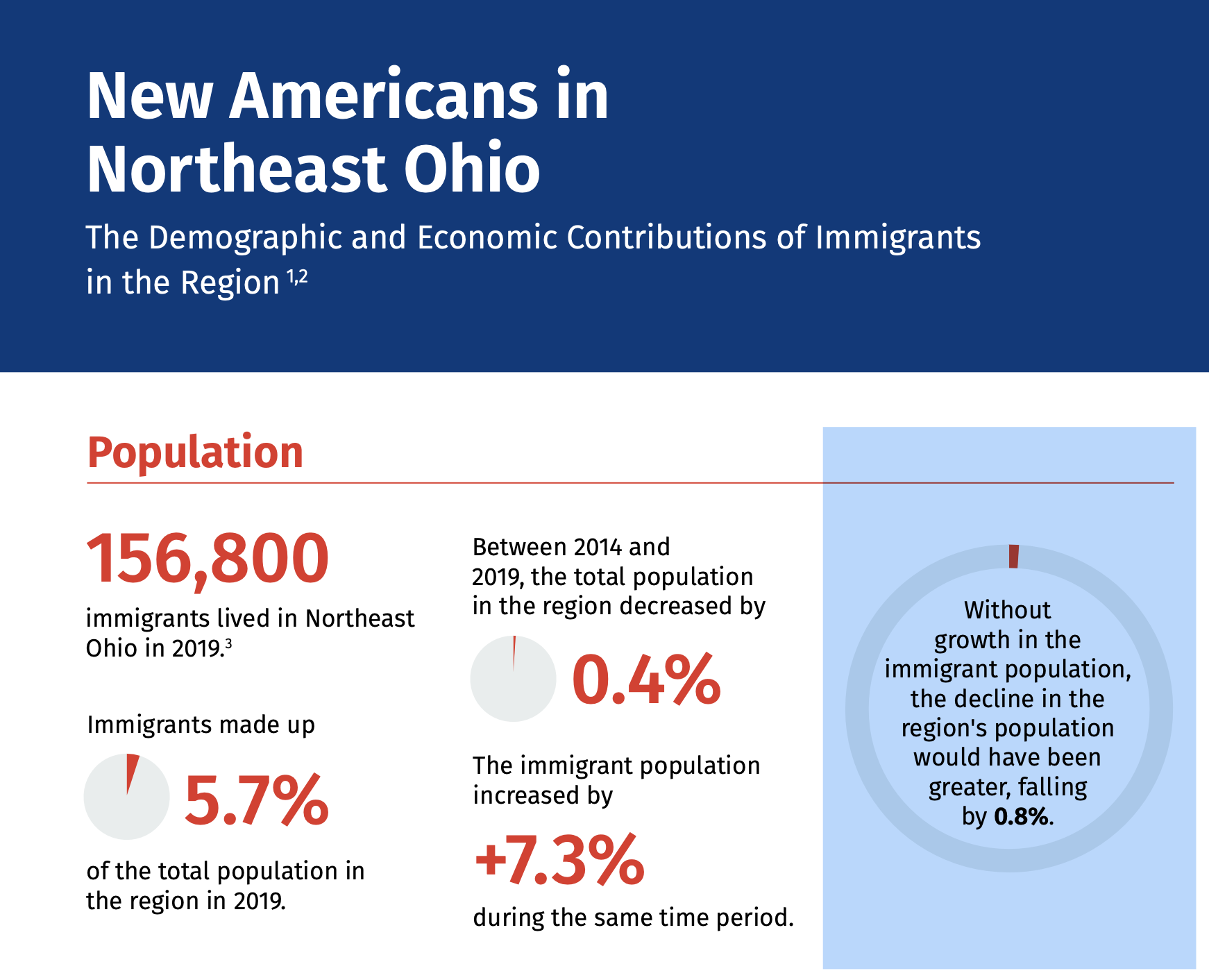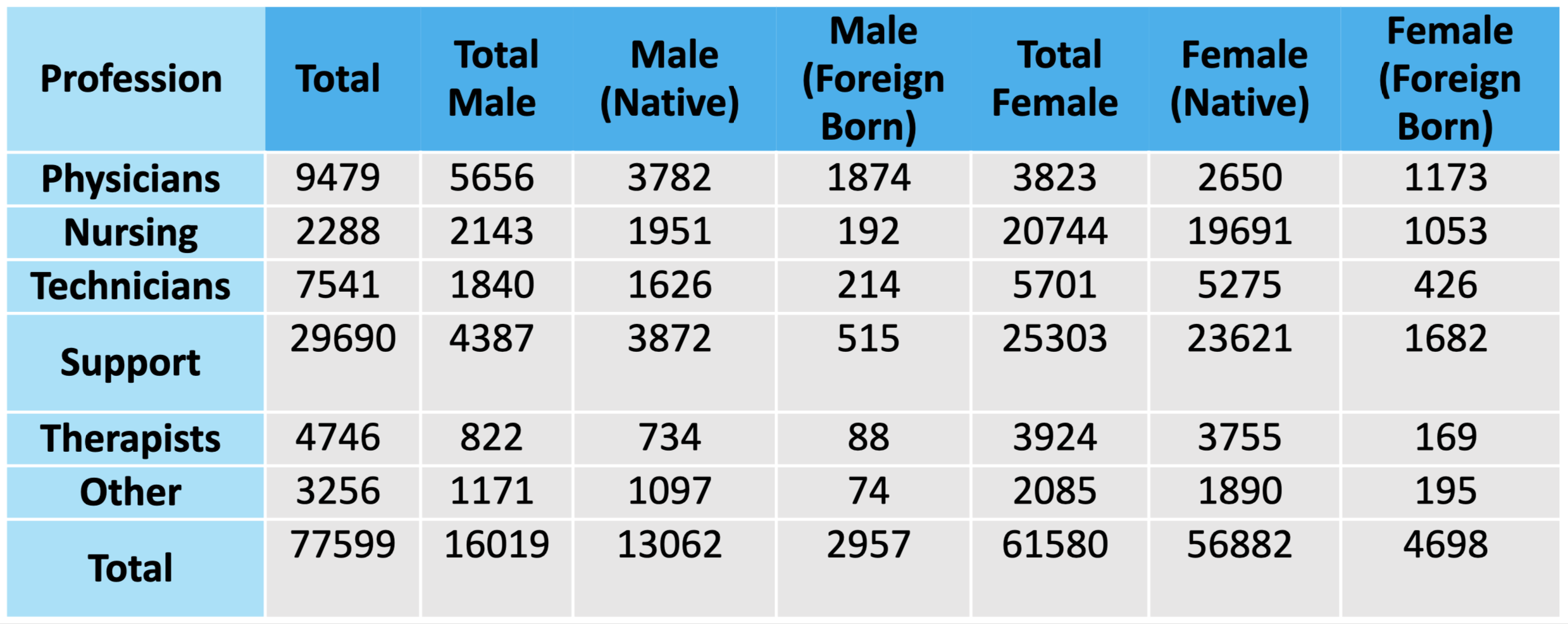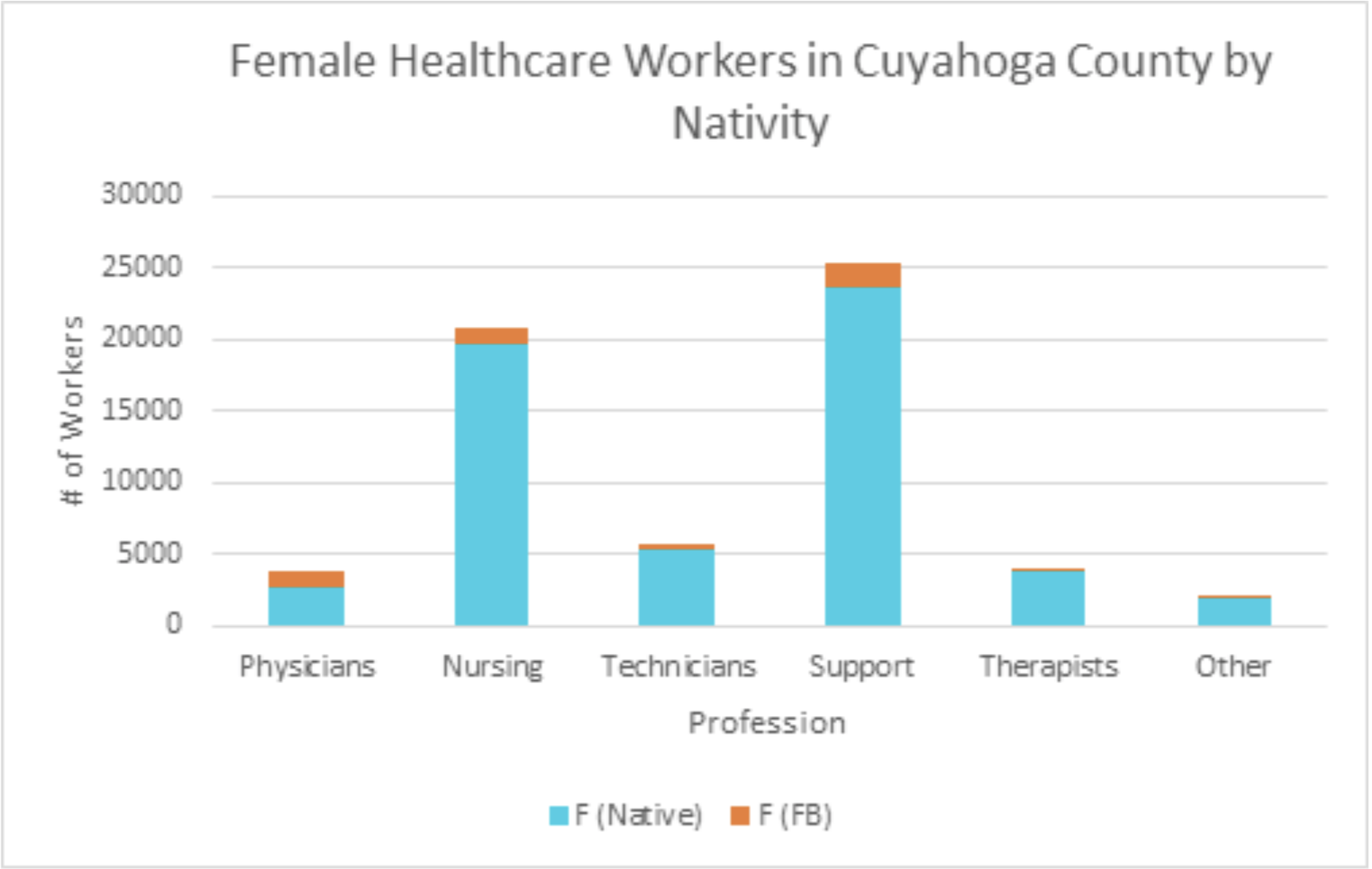
Immigrant Women in HealthcareData Observations
By Collin Derrig
In two short years, the Covid-19 pandemic has transformed life as we knew it. It has also deepened our knowledge of and appreciation for the role which healthcare workers play in our society. Unfortunately, there is a key demographic essential to our healthcare system at large that is recognized more by the color of their skin or their accents they carry than by their life saving work. This demographic is Immigrant Women, and we all owe them a heartfelt ‘thank you.’ Sadly, female immigrant healthcare workers still often get lost in the big picture. The following observations will partially explain the important role immigrant women play both nationally and locally in healthcare.
There are over 3.2 million foreign-born healthcare workers in the United States, comprising more than 17 % of the industry workforce. This is a disproportionate amount compared to the foreign-born percentage of the total population, only 13.7%. Of these 3 million+ immigrant healthcare workers, 2.39 million are female, or approximately 70%. While the most common career for foreign-born women working in healthcare is nursing (over 20%), these women are essential to the healthcare industry as a whole. Holding direct care roles such as physicians, home health aides, and therapists; as well as indirect care including administrative, technology, and other support staff, you will find an immigrant woman in every career in the healthcare industry. The national trend of immigrants being key here at home in Ohio and Cuyahoga County, however the details vary. Cuyahoga County is home to a total of 102,000 workers in healthcare related fields, while Ohio is home to a total of 867,000. Respectively there are 10,000 immigrant healthcare related workers in Cuyahoga County and 49,000 in the state. Interestingly, 1/5 of immigrant healthcare workers in Ohio reside in Cuyahoga County, while Cuyahoga County is home to only 1/10 of Ohio’s total population.
Healthcare Workers in Cuyahoga County by Gender and Nativity (ACS 2019 5-year Estimates)
Taking a closer look, excluding administrative and other non-medical healthcare positions, there are an estimated 77,600 healthcare workers in Cuyahoga County. Out of this number, 7,000 are immigrants and over 4,500 are female immigrants. That there are more female immigrants than male immigrants working in healthcare is unsurprising as over 79% of the county’s healthcare workers are female. Notably, immigrants as whole, and especially immigrant women play an outsized role as medical doctors. Although female immigrants comprise only around 6% of total healthcare workers in Cuyahoga County, they are 12% of all doctors and 30% of female doctors. Below are two charts showing in detail the proportion of immigrant women compared to other women across healthcare fields and their total numbers in said fields.
Both nationally and locally, healthcare workers have felt an outsized impact from the pandemic. According to numerous medical studies rates of depression, anxiety, stress, and other mental health issues have greatly increased for medical staff over the course of the pandemic. These intense psychological and physiological effects are frequently worse for minority healthcare workers, including immigrants, who already face other challenges in the workplace. Healthcare workers are also at much higher risk of being exposed and infected with Covid-19 and experiencing its potential life altering effects compared to the general population. Cuyahoga County is home to almost 20% of the state’s immigrant healthcare workers we can safely assume they have been similarly adversely affected by the pandemic. Especially with our COVID-19 case rates at times being among the highest in the state and the entire county. The thousands of immigrant healthcare workers here in Cuyahoga County and throughout Ohio have been key to stemming the effects of the pandemic and protecting all our lives. Recognizing this important role they play is the bare minimum they are due.
The data discussed above is just a small example of the key roles and impact that immigrant women play throughout our society. Immigrant women own businesses, hold essential jobs, and support families and entire communities. The millions of immigrant women that work in essential industries like agriculture, retail, food service, and shipping have been just as key to our survival during this pandemic as those working in healthcare. These contributions of international women have existed long before the pandemic and will undoubtedly continue to be a key to our success as a community in the future.
To learn more about the impact of immigrant women, join Global Cleveland during our 2nd annual celebration of International Women’s Month Celebration throughout the month of March. You can find a link to our programming here.
Sources
Article 2020: Immigrant Health-Care Workers in the.. | migrationpolicy.org
Immigrants in the United States | American Immigration Council
Immigrants as Essential Workers During COVID-19 – Center for American Progress
Impact of COVID-19 pandemic on healthcare workers (nih.gov)
Impact of COVID-19 pandemic on healthcare workers – PubMed (nih.gov)
COVID-19: a heavy toll on health-care workers – The Lancet Respiratory Medicine
ACS 2019 1 and 5 year Estimates/ US. Census Bureau
Women in healthcare | McKinsey
Women’s Safety and Health Issues At Work | NIOSH | CDC
February 23, 2022
Gateways For Growth Research Report

Our organization was awarded a grant to receive a customized research report that will help us improve immigrant inclusion in our communities!
Migration is Economic Development

Executive Summary
The sponsor of this analysis, Global Cleveland, is an organization, but global Cleveland is also a reality. Elaborating, when it comes to the task of economic and community development, think of a city as a feather in the wind, or a stick in a rapid of water. Global forces push and pull at places, affecting a city’s relevance, or it’s standard of living. Yet some indicators are better measures of where a city fits into the global order of things than others. This analysis shows that standard measures of “success”, like population size, are relics of a bygone era where size mattered. In today’s idea economy, a better measure is gauging the quality of life in city, not the quantity of lives. This analysis looks at GDP per capita for the nation’s large metros, defined as “the amount of output or income per person in an economy…that’s indicative of average productivity or average living standards.[i]”
The GDP per capita in the Cleveland metro is currently $ 57,700 and ranks 78th out of 374 metros. This is up from an inflation-adjusted $51,320 in 2010. To the extent Cleveland can prepare for progress entails examining what explains progress. The analysis looked at what features are driving GDP per capita growth across America’s metros from 2010 to 2019. To do this, Rust Belt Analytica deployed a machine learning algorithm called permutation feature importance. This is our “Progress Model”. Out of hundreds of variables analyzed, two clusters of features dominated the model results: educational attainment and migration. That is, the rate of a metro’s GDP per capita growth could be predictively explained by the educational attainment of a region, and the migration rates of a region. Migration features included the in-migration of college- and non-college-educated foreign born, and the in-migration of college- and non-college-educated native born, particularly if the domestic migrants were arriving from the Northeastern or Western parts of the U.S. This latter migration pattern of coastal-to-inland migration has been dubbed “The Rise of the Rest”, characterized as the convergence of American tech labor from the costly coast into the American heartland.
It is a pattern of migration that highly-educated immigrants have in fact been doing for some time. The analysis found that the percent of Cleveland’s immigrants with an advanced degree was 21.4%, which ranked 8th out the nation’s largest 40 metros. Interestingly, 6 out of the top 10 most highly-educated cities for immigrants were in the geographic area of the Rust Belt, led by Pittsburgh.
The analysis finds that migration is crucial to the evolution of cities. Migration does not only allow for the accumulation of human capital, but for global connectivity as well. Connectivity is part and parcel with the act of migration, allowing for the deepening of a city’s “thought bank”. This depth of ideation is crucial to the process of innovation which, in turn, is crucial economic evolution. Put another way, migration is economic development. It is today. It was yesterday. And it will be tomorrow. The issue for Cleveland is whether the region can leverage its global assets to incur its global relevance, and ultimately the increased well-being of its people.




